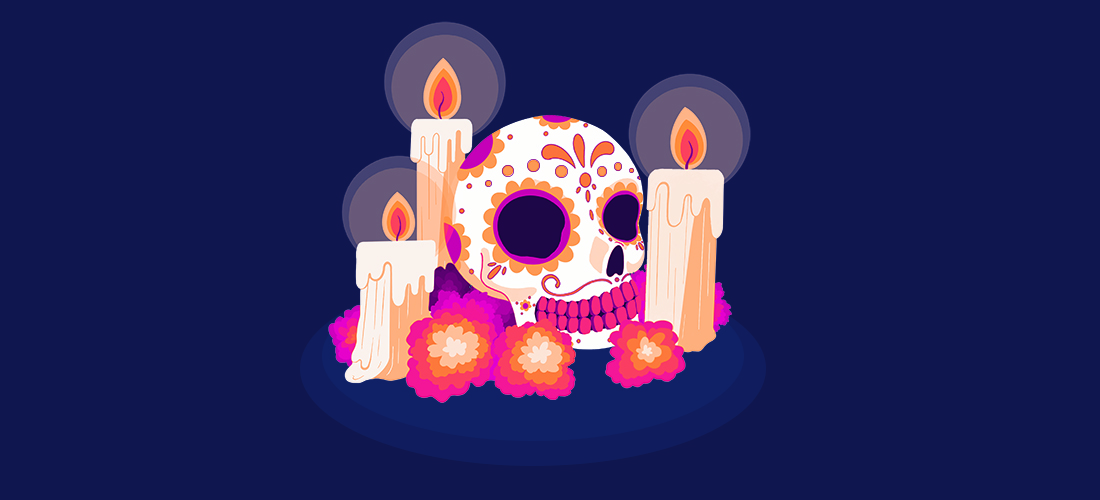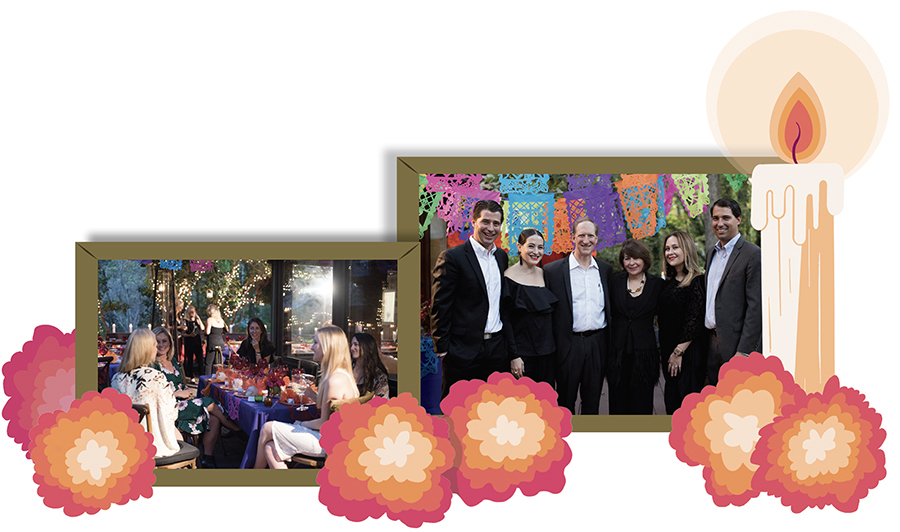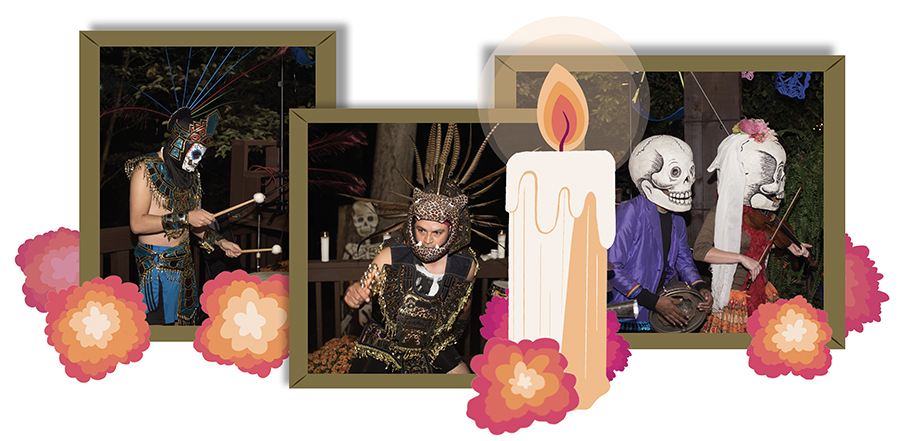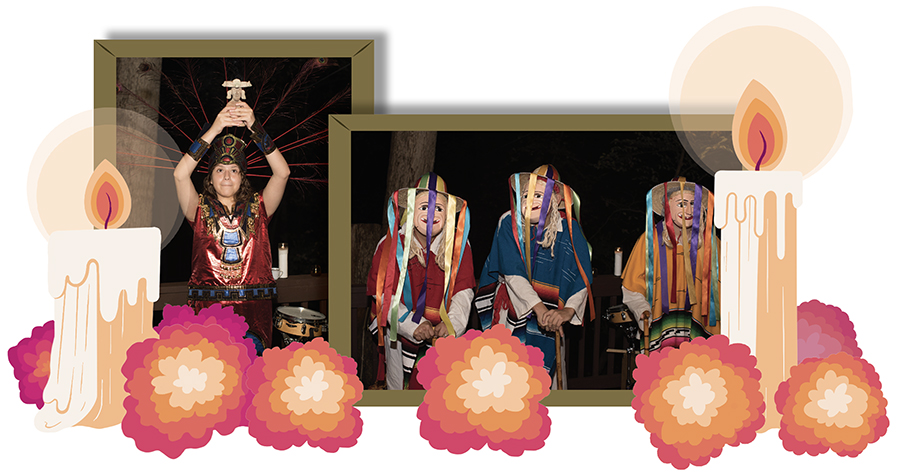
A family brings the spirit of the Purépecha to Greensboro
By Cassie Bustamante
Illustrations by Miranda Glyder
Just over 2,000 miles away, on the small Isla de Pacanda in Mexico’s Lake Pátzcuaro, the indigenous Purépecha are preparing for the island’s 3,000-year-old celebration of Día de los Muertos — or Day of the Dead.
Here in Greensboro, Alejandra Ochoa de Thompson, who grew up next to Lake Pátzcuaro, readies her own Sedgefield home with her family to recreate some of that legendary magic for a group of interior designers during High Point Furniture Market weekend.
On Día de los Muertos, it is believed that the veil between worlds — the living and the dead — lifts, allowing souls to return for one day. The living celebrate with and honor those who have passed away by offering gifts to their dearly departed — from favorite foods to items that reflect preferred colors and interests.
“In every way, they are trying to please the person [they lost],” says Thompson, founder and creative director of Thompson (formerly Thompson Traders), a family-run business that designs and imports artisanal, hand-crafted, metal sinks, tubs and range hoods from Santa Clara del Cobre in Mexico.
Daughter Samantha Thompson Lizarraga, the company’s former marketing director and a co-owner, chimes in, “To celebrate their life and to give it meaning . . . this keeps them alive.”
Embracing the opportunity to share a part of her personal history and the company’s legacy with the community that has supported her, Thompson looks forward to opening up her home for the night. “I think it is important to give a little piece of us — a little piece of what we have had,” she says.
“It was [my mom’s] dream to work with her children,” adds Thompson Lizaragga, “but also bring a piece of Mexico to the U.S. So we brought the sinks and this is an even further extension — the hospitality of Mexico.”

For one evening, Thompson transforms her own deck and backyard into a scene that feels directly transported from the Isla de Pacanda. A canopy of twinkling lights and golden-yellow floral garlands representing Cempaxochitl (“the Aztec marigold” and iconic Day of the Dead flowers) hang from the trees, cascading over the deck. Candles line the railings and grace brightly decorated tables set with copper chargers, colorful textiles and goblets, sugar skulls, and menus outlining the five-course meal. Every part of this event is replicated with meaning and deliberation based on the centuries-old ceremony.
In 2017, the company threw its first Day of the Dead party, with a plan to continue biannually. Of course, COVID struck, making the 2019 event the last for a while. But this year, the relatively new tradition will continue and hold even more significance for most than before.
“I think it’s going to be more emotional because we have lost so many people,” says Thompson. “Everybody has lost somebody.”
In March of 2020, Thompson lost its CEO and close family friend, Fred Starr, to COVID. His relationship with the family “ran deep beyond business,” notes Thompson Lizarraga, who adds that the company will be eternally grateful to him for turning it around, navigating through a time of struggle.
As the youngest of 14 children in “a family that has been so close,” Thompson, 71, has seen many in her family pass on before her, most recently her sister, Susana. This year’s celebration will be especially meaningful to her as she honors her sister as well as Starr.
“People will remember how you made them feel,” notes Thompson, recalling how her own parents made everybody feel welcome, her voice cracking with emotion. “They were the biggest givers . . . I hope I can keep doing the celebration” to carry on their legacy.
People and moments from Thompson’s long life — sprinkled with bits of the celebration’s history — are present in every detail, especially in the extensive food preparation and creation.
Thompson, who does all of the cooking herself, says that it’s a moment to reconnect with her past. “If I cook a dish, I immediately see myself with all of my brothers and sisters eating,” she says, her brown eyes sparkling as she fondly remembers her childhood in Mexico.
Each dish has a story. For instance, the mole, according to Thompson and Thompson Lizarraga, originated in a Mexican convent. Legend has it that “a very important bishop” was to visit and the nuns worried about what to feed him. One sister added peppers, and another tossed in chocolate. Thompson says, “Now a lot of people make a joke because the mole has —”
“— everything you can possibly dream of is in that dish!” interjects Thompson Lizarraga.
For Thompson, the many courses served at her party represent “a part of the culture, state or a city and the history behind each dish.”

Chiles en Nogada, or chiles in walnut sauce, is a dish featuring green poblano peppers stuffed with a mixture of meat in a white cream sauce topped with red pomegranate seeds. As Thompson Lizarraga notes, the dish features the colors of the Mexican flag, celebrating the country’s own Independence Day.
This time around, Thompson plans to place descriptive cards by each dish denoting its significance, whether historical or familial.
The traditions of her country of origin are shared not only in the meal itself, but in the way the foods are presented over time. “My sister says in Mexico food is a sport,” laughs Thompson Lizarraga. “And this is still true for all of Mexico. Lunchtime is a two-hour period where you sit and have several courses . . . and talk with people and eat.”
“At the party, it’s three [hours],” adds Thompson, who wants her guests to have time to relax as they converse with others. What she offers, in addition to a delicious array of Mexican foods, is an opportunity for genuine connection. “If you take a little time to eat, sit in front of each other, you have to communicate,” she says. “And life is moving so fast now — it’s become so impersonal.”
After food and conversation follows live entertainment inspired by the festivities on the Isla de Pacanda. Thompson paints a picture of what the entire night looks like in Mexico, beginning with a candlelit boat ride to the island where a violinist or guitarist serenades riders with mournful yet beautiful songs about death. On the island, a parade of Catrinas and Catrins, which originated as a satire of European high society, marches along to melancholy music that “makes you cry. Because you almost feel the presence of all these souls that left — but you wonder in that moment.”
The festivities on the island run all through the night. “The cartoon Coco is not very far off,” says Thompson Lizaragga, referencing Disney’s 3-D, animated classic about a trip to the Land of the Dead.
At Thompson’s own party, there will be a similar, smaller parade, live music and dancers. She describes Paperhand, a company out of Saxapahaw that makes its own masks and costumes and will perform among the trees in her backyard the evening of the party. Paperhand has its own band, including a singer who sounds similar to the late renowned Costa Rican-Mexican singer Chavela Vargas.
“She had a strong voice,” says Thompson, “and she’d sing those songs and immediately transport you to another place — very sad and very dramatic.”
One song, in particular, she was known for is “La Llorona,” which means “the one who cries,” according to Thompson Lizarraga. While music is a universal language that can convey emotion, Thompson hopes this year to have some of the songs translated for her guests so that they can understand the words as well.
This year’s party will be the company’s third and, as Thompson Lizarraga says, “Every time we do it, it gets better. It gets more exciting.”
And with each passing year, the family sees how the party impacts its guests. In 2019, a designer who had lost a child was in attendance. Thompson recalls that when the guest left that evening, she told her hostess, “Oh my gosh, I am going to feel different now.” This year, according to Thompson, she plans on lighting a lantern for her child.
Thompson’s wish is that her guests this year are similarly transformed — that they leave with a sense of genuine connection, a feeling “that we have hope, that the soul exists, that we are one . . . that the soul is one.”
Thompson Lizarraga adds, “The world needs that right now: To remember whether you’re left or right, whatever your beliefs are, we’re all just people.”
While the veil between the worlds of the living and the dead lifts for just 24 hours, according to Mexican beliefs, the Thompson family’s hope is that the feeling of unity cultivated during its Day of the Dead party carries on well past that, and that we continue to honor the dead, but that we take the opportunity to be truly present today. OH
Cassie Bustamante is managing editor of O.Henry magazine.






